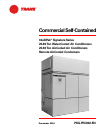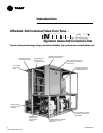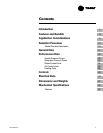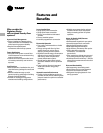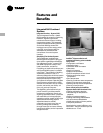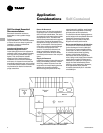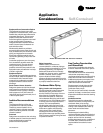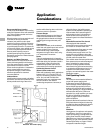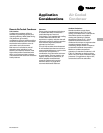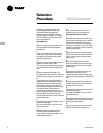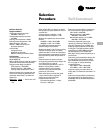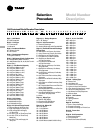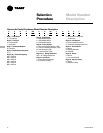
Application
Considerations
PKG-PRC002-EN 9
Double Stud Offset Wall with Interwoven Insulation
Equipment Room Construction Options
The preferred equipment room wall
construction is concrete block. If this is not
feasible then a double stud offset wall is
suggested (See figure). This removes
physical contact that would transmit
sound through the equipment room wall
to the occupied space. Interweave
fiberglass insulation between the wall
studs. Use two layers of sheetrock on
each side of the wall.
Workmanship details are critical to
acoustical performance. Seal all wall and
floor penetrations by the ductwork, water
piping, and equipment room access
doors with a flexible material such as
caulk and/or gasketing to stop noise and
air leaks.
Locate the equipment room door away
from acoustically sensitive areas like
conference rooms. The door should
swing out of the equipment room, if
possible, so that the low pressure in the
equipment room pulls the door in to help
maintain a tight seal.
Equipment Options
The flexible horizontal discharge plenum
allows multiple tested outlet options. This
minimizes the risk of acoustic and/or
pressure drop problems by avoiding
complex transitions close to the fan
discharge.
Static Pressure Versus Acoustics
Design the system to minimize the total
static pressure required from the self-
contained unit fan. Typically a change in
static pressure of only 0.5 inches can
reduce NC level by approximately 2 or 3
in the occupied space.
Isolation Recommendations
Unit
The Signature Series unit fan and
compressors are internally isolated.
Therefore, external isolation is not
required. Consult a vibration specialist
before considering external or double
vibration isolation.
Ductwork
Design duct connections to the unit using
a flexible material. Consult local codes for
approved flexible duct material to
prevent fire hazard potential.
Piping Connections
Rubber isolator connectors are
recommended for condenser piping to
prevent vibration transmission to or from
the building plumbing. The Signature
Series self-contained unit is internally
isolated and does not require additional
isolation. However, ensure proper
system vibration isolation design
prevents vibration transmission from the
building plumbing to the unit. Also be sure
to properly isolate the drain line.
Condenser Water Piping
Piping Location and Arrangement
Provide at least 24 inches of clearance
between the piping and the unit for
service. Place the risers away from the
side of the unit if possible. Be sure to
allow sufficient space for valves and
unions between the piping and the self-
contained unit. Lay out condenser piping
in reverse returns to help balance the
system. This is accomplished by
equalizing the supply and return pipe
length. Multi-story buildings may use a
direct return system with balancing
valves at each floor. Install all heat
exchangers and most cooling tower
piping below the sump operating water
level to prevent overflow during unit and/
or system shut down.
Free Cooling Opportunities
and Alternatives
Free cooling is available with either the
airside or waterside economizer options.
Waterside Economizer
The waterside economizer substantially
reduces the compressor energy
requirements because it uses the cooling
water before it enters the condensers.
Additional equipment room space is not
required since the coils are contained
within the overall unit dimensions.
Disadvantages include higher airside
pressure drop and a higher head on
condenser water pumps.
The coils may be mechanically cleanable
(optional) for ease in maintenance versus
expensive and difficult chemical cleaning
methods.
Airside Economizer
The airside economizer substantially
reduces compressor, cooling tower, and
condenser water pump energy
requirements using outside air for free
cooling. It also reduces tower make up
water needs and related water
treatment.
Disadvantages include building
requirements that locate the mechanical
room and self-contained unit toward an
exterior wall to minimize ductwork ,
building barometric control, or additional
air shafts. Also, airside economizers
require additional mechanical room
space.
Self-Contained



